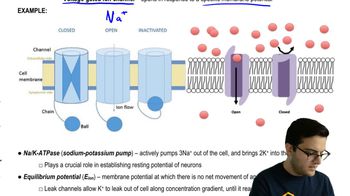Consider the following statements regarding the transport of phloem sap. Select True or False for each statement. T/F This is a passive process that is driven by the evaporation of water from leaves. T/F Sugars tend to move from sources to sinks. T/F Phloem sap moves through sieve-tube elements under positive pressure. T/F Sieve-tube elements and vessel elements are commonly involved in the transport of phloem sap.
A mutant plant lacking the ability to pump protons out of leaf companion cells will be unable to do which of the following? a. initiate transpiration b. load sucrose into sieve-tube elements c. carry out photosynthesis d. transport water through the xylem
 Verified step by step guidance
Verified step by step guidance
Verified Solution
Key Concepts
Proton Pumping

Sieve-Tube Elements

Transpiration

The cells of a certain plant species can accumulate solutes to create very low solute potentials. Which of these statements is correct? a. The plant's transpiration rates will tend to be extremely low. b. The plant can compete for water effectively and live in c. relatively dry soils. d. The plant will grow most effectively in soils that are saturated with water year-round. e. The plant's leaves will wilt easily.
Draw a plant cell in pure water. Add dots to indicate solutes inside the cell. Now add more dots to indicate an increase in solute potential inside the cell. Add an arrow showing the net direction of water movement in response. Add arrows showing the direction of wall pressure and turgor pressure in response to water movement. Repeat the same exercise, but this time, add solutes to the solution outside the cell at a concentration that is greater than inside the cell.
Your friend claims that phloem always carries sugars down a plant. What, if anything, is wrong with that statement?
Consider a tree that is 50 m tall and is transpiring roughly 90 liters of water each day. Approximately how many calories will the tree use to transpire this quantity of water?
Salt is used to melt snow and keep roads clear during the winter in many cities. Land adjacent to de-iced roads often ends up with a high concentration of salt in the soil. Explain why plants growing near salted roads may appear wilted in the spring.
